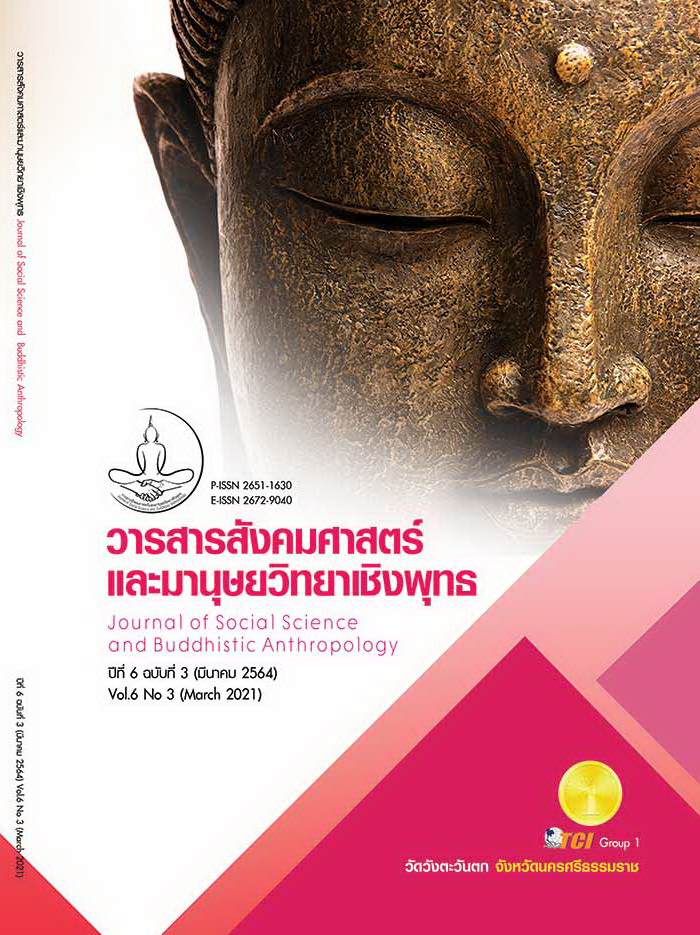A STUDY THE NEEDS OF USING THAI LANGUAGE IN BUSINESS FOR CHINESE STUDENTS AT YUNNAN UNIVERSITY OF FINANCE AND ECONOMICS OF CHINA
Keywords:
Needs, Using Business Thai Language, Chinese StudentsAbstract
The Objectives of this research article were to 1) Study the needs of using Thai language in business for Chinese students at Yunnan University of Economics and Finance, China 2) Explore ways to empower Chinese students in Yunnan University of Economics and Finance in China with capacity and competence of learning to enhance Thai language proficiency especially in business. The sample group used in the research are consist of 3 graduate employers, 5 Chinese graduates in Thai language program, 3 Thai language in business teaching specialist, and 103 Chinese students in Thai language program. There are two types of research instruments including structural interview and rating scale questionnaire are adopted in this research. Data collection is divided into 2 phases: Phase I, data have been collected through in-depth interviews, and Phase II, collecting data by using questionnaires distributed to the Chinese students in Thai language program. The statistics used for data analysis are mean and standard deviation The results of the research suggest that: In Chinese business, there is a need for Chinese students in Thai language program from Yunnan University of Economics and Finance, have the ability to use Thai language in 7 business contexts including workplace, service, business seminar, business travel, trade, investment, and hospitality contexts. Results of data analysis suggest that Chinese students in Thai language program need to use Thai language in business at the high level ( = 4.23, S.D.=0.85). Analysis of guidelines for teaching development of Thai language in business courses for Chinese students can be divided into 3 ways including curriculum development, development of teaching and learning activities, and development of teaching materials.
References
บุญชม ศรีสะอาด. (2556). วิธีการทางสถิติสำหรับการวิจัย เล่ม 1. กรุงเทพมหานคร: สุวีริยาสาส์น.
ประคอง นิมมานเหมินท์. (2552). บรรทัดฐานภาษาไทย เล่ม 4 วัฒนธรรมการใช้ภาษา. กรุงเทพมหานคร: องค์การค้าคุรุสภา.
พนมพร นิรัญทวี. (2540). ภาษาไทยธุรกิจ. กรุงเทพมหานคร: ภาควิชาภาษาไทย คณะศิลปศาสตร์ มหาวิทยาลัยธรรมศาสตร์.
ศศิณัฎฐ์ สรรคบุรานุรักษ์. (2560). สื่อมัลติมีเดียและเทคโนโลยีกับการสอนภาษาจีนในศตวรรษที่ 21. วารสาร Veridian E-Journal, Silpakorn University, 10(3), 1239-1256.
ศิวภรณ์ หอมสุวรรณ. (2543). ภาษาไทยธุรกิจ. เชียงใหม่: ภาควิชาภาษาไทย คณะมนุษยศาสตร์และ สังคมศาสตร์ มหาวิทยาลัยราชภัฏเชียงใหม่.
โศภน รัตนะ. (2556). ผลการใช้เอกสารประกอบการเรียน เรื่องภูมิศาสตร์ทวีปออสเตรเลียและโอเชียเนียที่มี ต่อผลสัมฤทธิ์ทางการเรียนของนักเรียน ชั้นมัธยมศึกษาปีที่ 1 โรงเรียนชะรัตชนูปถัมภ์ จังหวัดพัทลุง. ใน วิทยานิพนธ์ศึกษาศาสตรมหาบัณฑิต สาขาวิชาหลักสูตรและการสอน. มหาวิทยาลัยสุโขทัยธรรมาธิราช.
สำนักงานคณะกรรมการนโยบายเขตพัฒนาพิเศษภาคตะวันออก. (2563). โครงการพัฒนาระเบียงเศรษฐกิจ พิเศษภาคตะวันออก (อีอีซี) เป็นแผนยุทธศาสตร์ภายใต้ไทยแลนด์ 4.0. เรียกใช้เมื่อ 26 พฤษภาคม 2563 จาก https://www.eeco.or.th/th
สิระ สมนาม และคณะ. (2552). ลักษณะการเรียนรู้และกลวิธีการเรียนรู้ภาษาของนักศึกษาชาวจีนที่เรียน ภาษาไทยในฐานะภาษาต่างประเทศ ณ สถาบันอุดมศึกษาเขต ภาคเหนือตอนบน. วารสารวิชาการ มหาวิทยาลัยฟาร์อีสเทอร์น, 2(2), 80-83.
อรทัย ธารีเกษ. (2559). การพัฒนาหลักสูตรเสริมสร้างคุณลักษณะบุคคลแห่งการเรียนรู้สำหรับ นักเรียนระดับประถมศึกษา. ใน ดุษฎีนิพนธ์การศึกษาดุษฎีบัณฑิต สาขาการวิจัยและพัฒนา. มหาวิทยาลัยศรีนครินทรวิโรฒ.
เอกฉัท จารุเมธีชน. (2549). ภาษาไทยธุรกิจ. กรุงเทพมหานคร: โอเดียนสโตร์.
Cronbach, L. J. (2003). Essential of psychology testing. New York: Hanpercollishes.
Dudley - Evans, T. & John, M. J. (2007). Developments in English of Specific Purposes. Cambridge: Cambridge University Press.
Finocchiaro, M. & Brumfit, C. (1983). The functional-Notional Approach from Theory To Practice. New York: Oxford University Press.
Hutchinson, T. & Walters, A. (1994). English for Specific Purposes. Cambridge: Cambridge University Press.
Likert, R. A. (1932). Technique for the Measurement of Attitude. Archives Psychological, 3(1), 42-48.
Mackay, R. & Mountford, A. (1978). English for Specific Purposes. London: Longman.
Office of the Leading Group for the Belt and Road Initiative. (2020). Belt and Road Portal. Retrieved May 26, 2020, from https://www.yidaiyilu.gov.cn/ ztindex.htm
Strevens, P. (1977). Special purpose language learning: A perspective. Language Teaching and Linguistic Abstracts, 10(1), 145-163.








